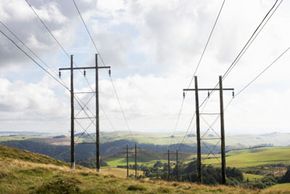Tesla's Breakthrough
Engineer Nikola Tesla, aided by theoretical work by Charles Proteus Steinmetz, came up with the idea of using alternating current, or AC. Unlike direct current, AC is always changing and repeatedly reverses direction.
So why was AC the answer to the problem of long-distance power transmission? With AC, it's possible to use transformers to change voltage levels in a circuit. Transformers work on a principle of magnetic induction, which requires a changing magnetic field produced by the alternating current. With transformers, voltages can be increased for long-distance transmission. At the receiving end, the voltage level can decrease to a safer 220V or 110V for business and residential use.
Advertisement
We need high voltages for long distances because wire resistance causes power loss. The electrons bumping into atoms lose energy in the form of heat as they travel. This power loss is proportional to the square of the amount of current moving through the wire.
To measure the amount of power the line transmits, you can multiply the voltage by the current. You can express these two ideas using an equation in which I represents current, V represents voltage and P equals power:
P = V x I
Let's consider the example of transmitting 1 megawatt. If we increase the voltage from 100V to 10,000V, we can then decrease the current from 10,000A to 100A. This will reduce the power loss by (100)2, or 10,000. This was Tesla's concept, and from that idea power transmission from Niagara Falls to Buffalo, and ultimately to New York City and beyond, became a reality.
In the United States and many other countries, the standard frequency for AC power is 60 cycles per second, or 60 hertz. This means that 60 times a second, a complete cycle of the current flows in one direction and then in the other. The current flows in one direction for 1/120th of a second and in the other direction for another 1/120th of a second. The time it takes for one cycle to be completed is called a period, which in this case is 1/60th of a second. In Europe and other areas, the standard frequency for AC power is 50 hertz.
Electronic circuits need both AC and DC. We'll learn about them on the next page.
